Korean Mackerel and Radish Recipe
This braised spicy Korean mackerel and radish (godeungeo jorim) recipe is a beloved Korean fish dish. The step-by-step instructions and cooking tips will help you to cook this delicious fresh mackerel without the worry of fish odor.
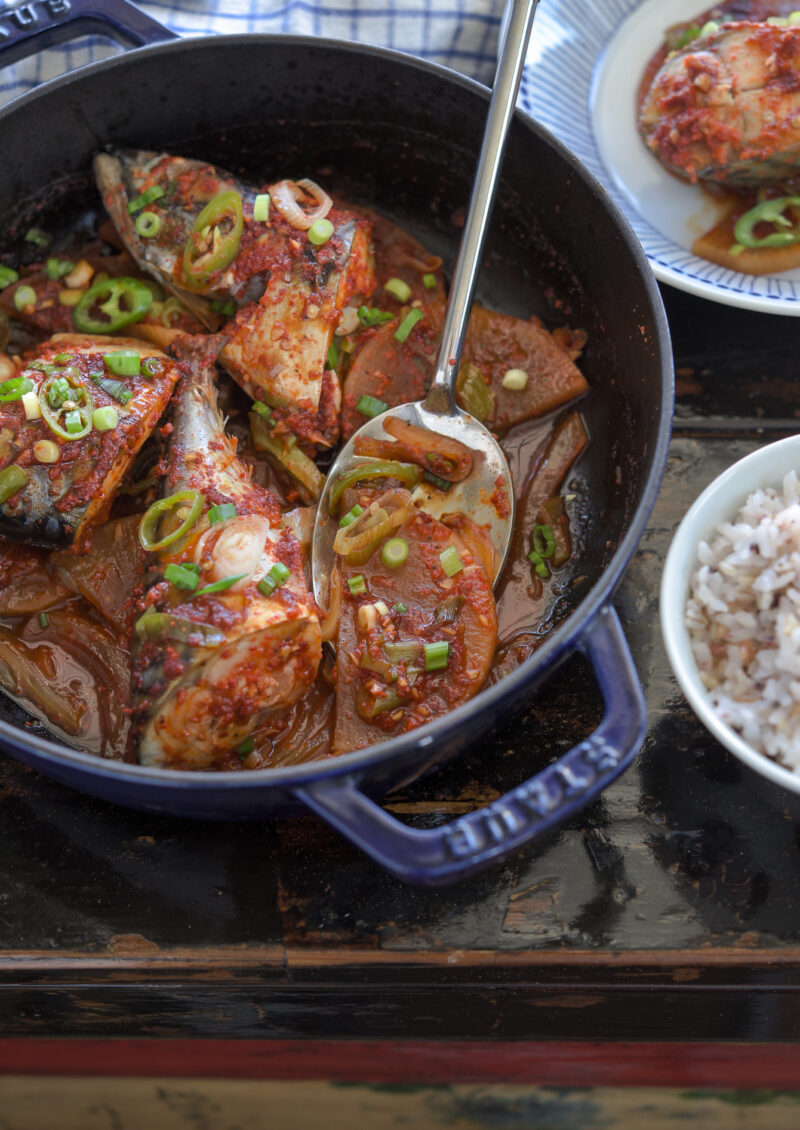
Korean Mackerel Recipe
Mackerel is a beloved fish in Korea. Out of many mackerel dishes, this Korean braised mackerel and radish (godeungeo jorim, 고등어 조림) is perhaps the most well known and popular one among Korean home cooks.
Mackerel pieces are topped with a slightly spicy chili seasoning sauce and cooked with slices of Korean radish. It is actually a very simple recipe and the outcome is enjoyable. You will love the tender and flaky meat mackerel offers.
Interestingly, my favorite part of this dish is actually the radish. The mellow and almost sweet Korean radish is what Koreans call a “rice stealer” (bap doduk, 밥도둑).
What is a “rice stealer?” Some dishes are so tasty that you can’t stop yourself from eating it. Since most Korean dishes are eaten with rice, you will unwittingly consume a lot of rice. Soon you will look into your bowl and think, “hey, where did all my rice go?” You can blame the delicious “rice stealer” dish!
This recipe serves only 2-3 people. You can easily double the recipe and feed the entire family. Serve this braised mackerel with freshly cooked rice and one or two Banchan (Korean side dishes). You will enjoy the true taste of Korean fish. Yummy!
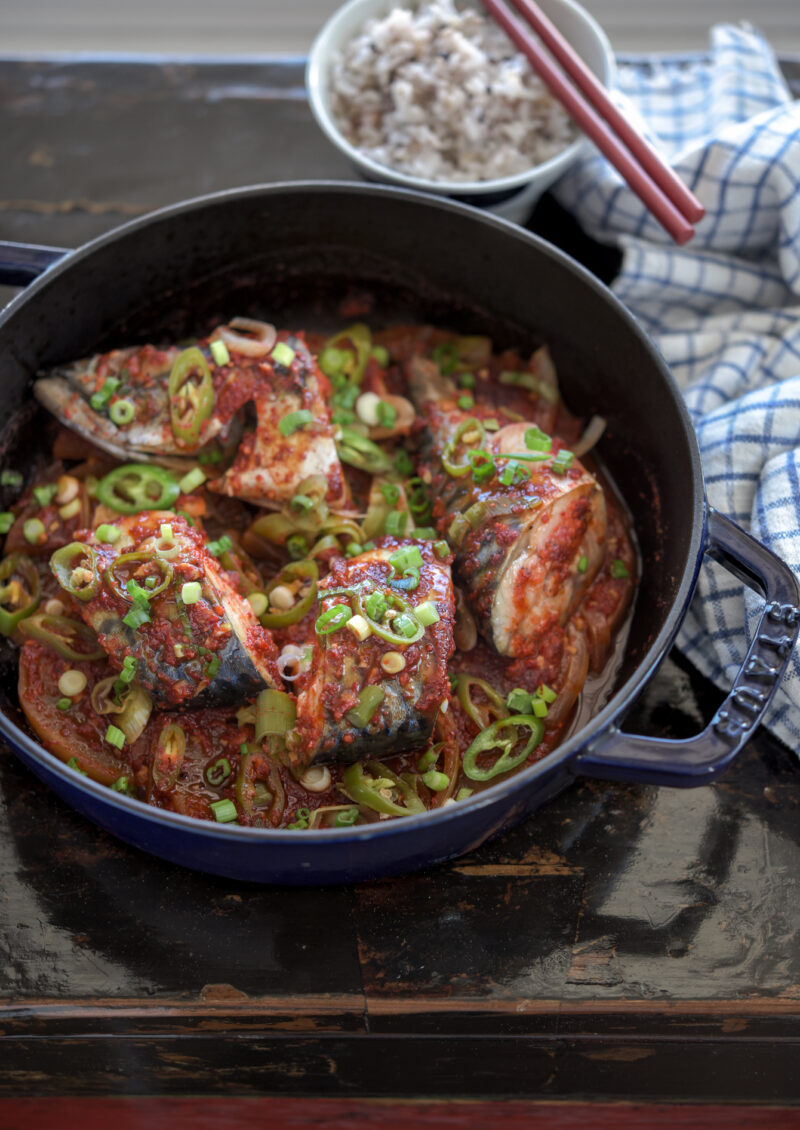
Worried about that Fish Odor?
I know fish dishes are not everyone’s favorite. Some people are hesitant to cook with fish because they worry about the fish odor while cooking or a fishy aftertaste.
With my recipe, you won’t have to worry about these issues. I will share some good, simple tips how to prep the fish to minimize the fish odor. You can do it!
How to Choose Fresh Mackerel
A good fish dish should always use the freshest fish possible. Mackerel fish is known as an oily fish with healthy fat – think of omega-3 fatty acid.
The best way to tell mackerel is fresh is by smelling it. If it smells sour, avoid it. Also, look for clear and bright eyes. If the mackerel has dull or grey eyes then it has been out of water a very long time. Finally, look for a vivid and shiny skin tone.
If the mackerel is not very fresh, it is probably still safe to eat, but it will have a strong fish odor.
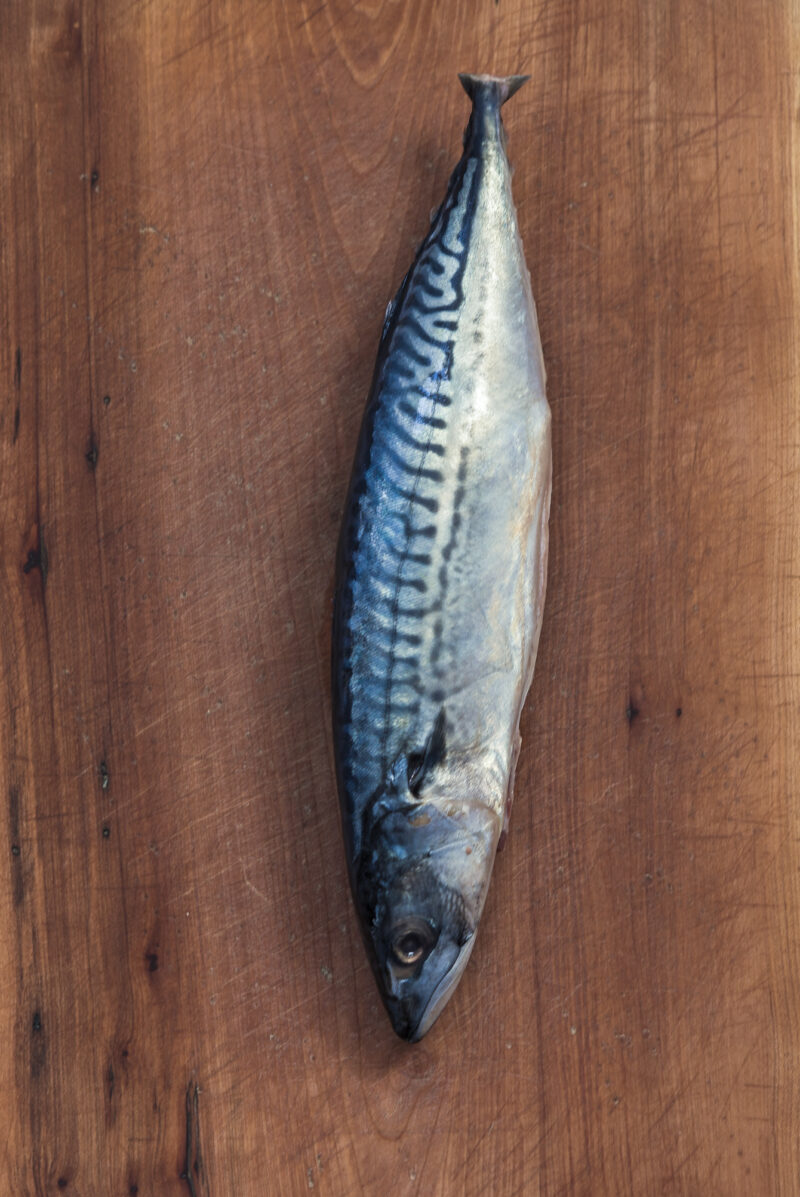
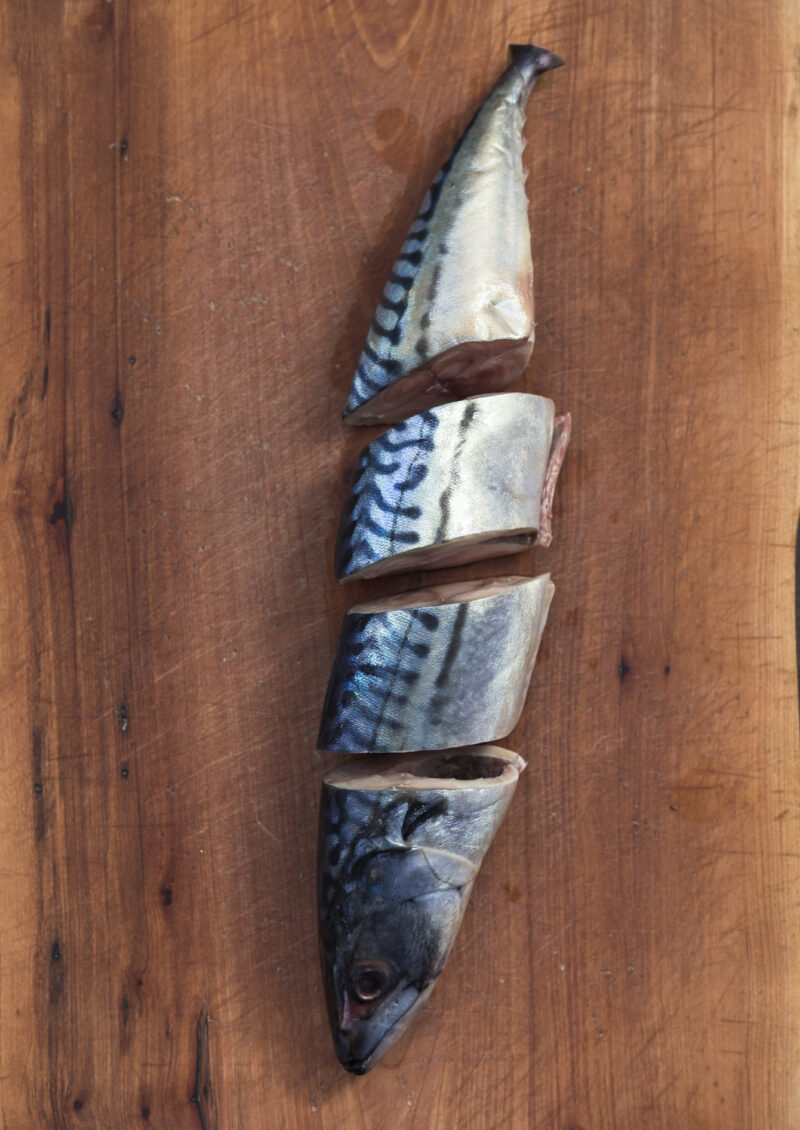
You might worry about fish odor when using the whole fish, including the head. And it’s true, some fish create a fish odor during cooking no matter how well the fish has been cleaned.
Mackerel is notorious for its fishy smell, but I will share a tip that can minimize the smell and give you peace of mind.
How to Prevent the Fish Odor
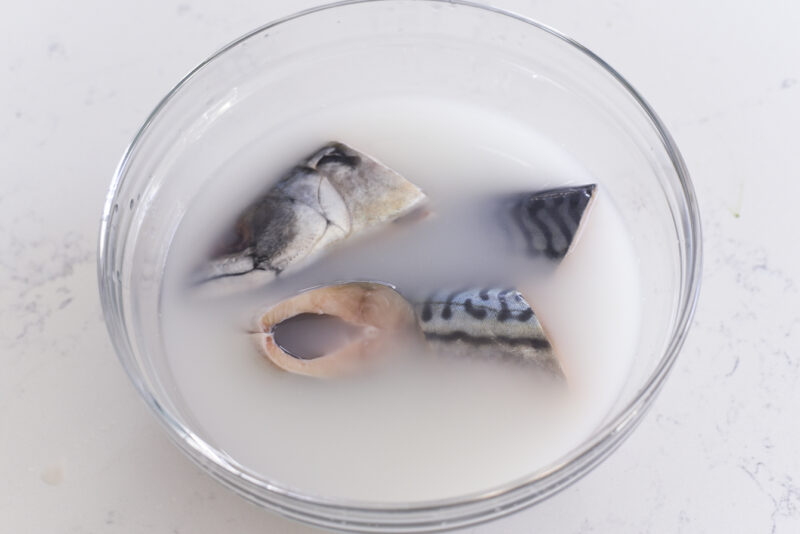
It’s simple: use rice starch water. What is that, you ask?
Rice water (aka rice starch water) is basically the water that you used to rinse the rice. Just collect a few cupfuls of starch water after you rinse your rice.
I can’t explain scientifically how the rice starch water reduces fish odor, but it works. My mother always used this method, as do many other Korean cooks.
Besides, you will want to eat this braised mackerel with radish dish with rice, and you will need to wash your rice anyway, so there’s no extra work involved. Please go to my How To Make Rice Water page for an easy tutorial.
Soak the well-cleaned mackerel pieces in rice starch water for 10-15 minutes. Drain and proceed with the rest of the recipe. That’s all. Simple, right?
Braised Korean Mackerel and Radish Recipe Instructions
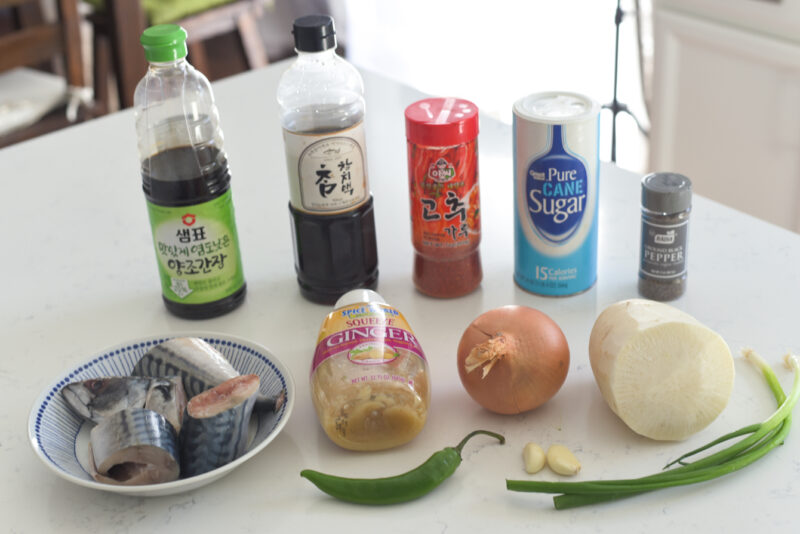
Ingredients you need: mackerel, fresh green chili, garlic, green onion, Korean radish, onion, ginger, soy sauce, Korean tuna sauce, Korean chili flakes, sugar, and pepper.
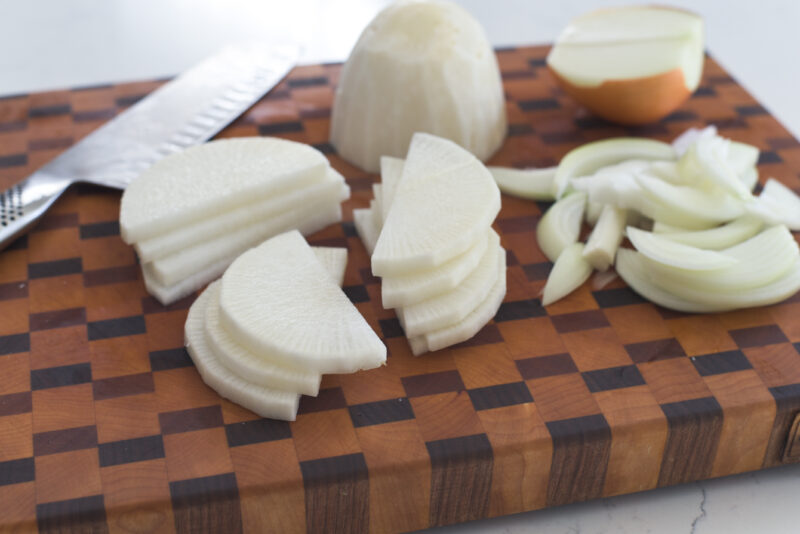
Cut Korean radish into 1/4-ich thick slices. Slice onion thinly. If you don’t have a Korean radish, use daikon radish or turnip.
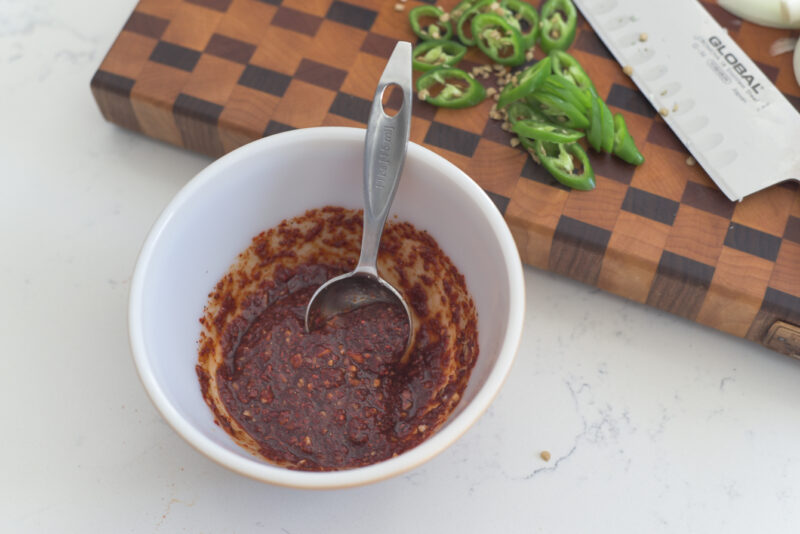
Combine all the chili seasoning sauce in a small bowl and mix well.
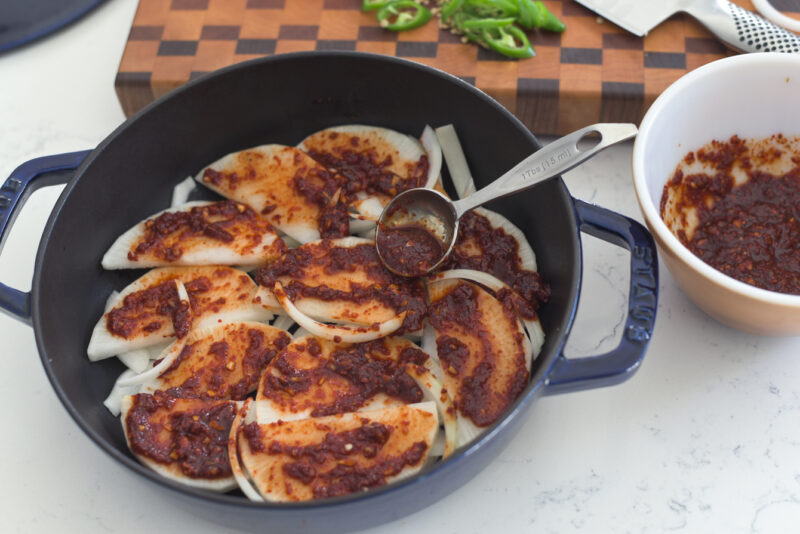
Scatter the onion on the bottom of pan, and place radish slices evenly. Spread half the amount of chili seasoning sauce on top.
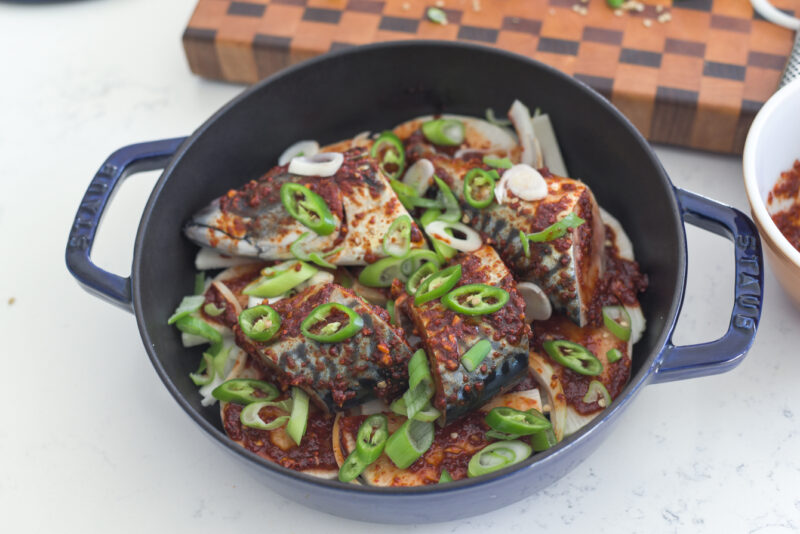
Place mackerel pieces on top of the onions and radish, then spread the remaining sauce on the mackerel. Sprinkle chili slices on top.
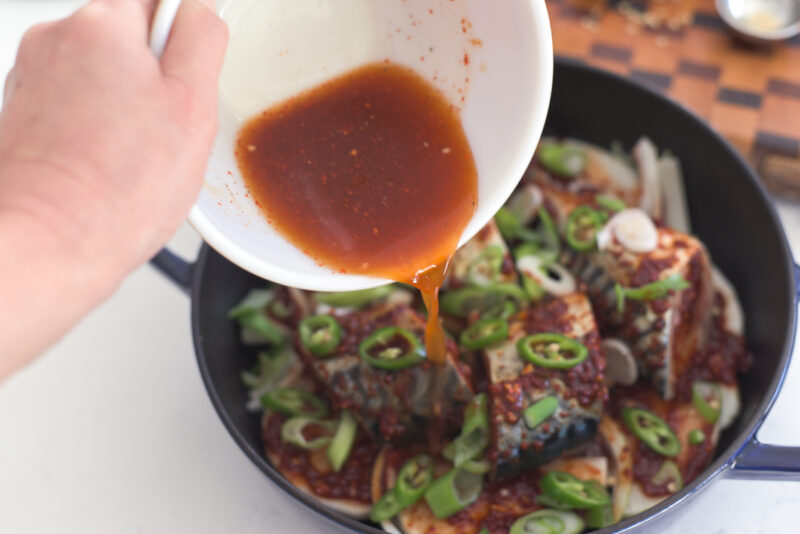
Put water in the chili seasoning sauce mixing bowl and swirl around to collect all the residue inside the bowl, then pour it into the pot.
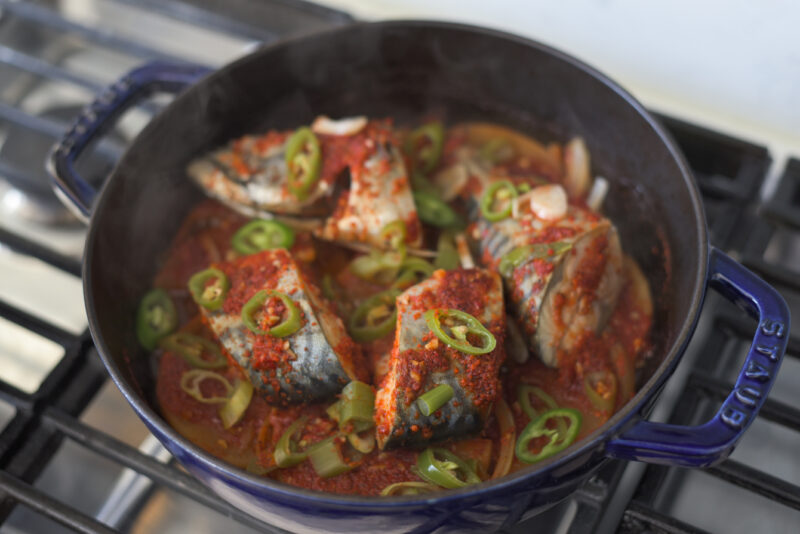
Cover and bring it to boil. Reduce the heat to low and simmer for 15-20 minutes until radish is softened. Sprinkle with chopped green onion. Serve warm with rice.

As I mentioned earlier, my favorite part of this dish is the radish. Of course, there’s no doubt that mackerel is so flaky tender and delicious. You won’t smell any fishy odor at all.
The soft mellow Korean radish soaks up all the good flavor. Try it with rice! And you will know why it is called “a rice stealer” (bapdoduk, 밥도둑).
More Fish Recipes
- Grilled Fish with Soy Lime Chili Sauce
- Grilled Mackerel (in Parchment Paper)
- Mexican Fish, the Rodrigo-style fish
- Spicy Yellow Croaker Fish Stew, Jogi MaeUn-Tang
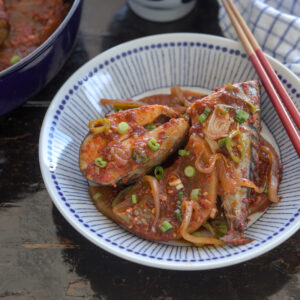
Korean Mackerel and Radish Recipe
Ingredients
- 1 whole mackerel fish, well-cleaned and cut into 3-4 pieces
- 3 cups rice water, see note below
- 10 oz Korean radish, thinly sliced
- 1/2 large onion, sliced
- 1 fresh chili, sliced, optional
- 1 green onion, chopped
For chili seasoning sauce
- 2 tbsp Korean chili flakes (gochugaru)
- 3 tbsp soy sauce
- 1 tbsp Korean tuna sauce
- 2 cloves garlic, finely minced
- 2 tsp ginger paste
- 1/2 tsp sugar
- 1/2 tsp pepper
- 1/2 cup water
Instructions
- Soak the well-cleaned mackerel pieces in rice starch water for 10-15 minutes. Drain and set aside.
- Meanwhile make the seasoning paste. Combine chili flakes, soy sauce, tuna sauce, garlic, ginger, sugar, and pepper in a small mixing bowl.
- In a shallow braising pot, scatter the onion on the bottom of pan, and place radish slices evenly. Spread half the amount of chili seasoning sauce on top. Place mackerel pieces on top of the onions and radish, then spread the remaining sauce on the mackerel.
- Put 1/2 cup of water in the chili seasoning sauce mixing bowl and swirl around to collect all the residue inside the bowl, then pour it into the pot.
- Cover and bring it to boil. Reduce the heat to low and simmer for 15-20 minutes until radish is softened. Sprinkle with chopped green onion. Serve warm with rice.
Notes
- Rinse your rice with water briefly. Pour out the water and discard.
- Swirl the rice around rapidly with your fingers for 15 seconds to remove starch from the rice grains.
- Pour about 3 cups of water to the rice and rinse.
- Collect the milky rice starch water in a bowl and add the mackerel pieces.
- Continue to rinse your rice 2-3 more times. Cook your rice by your usual rice cooking method.


My grandma used to make this all the time. Made it this weekend and all the smells were so comforting and familiar. Take you for recreating this memory for me.
Hi Isabell
This is a true Korean homey fish dish that brings lots of childhood nostalgia. I am sure your grandma’s is extraordinary delicious. Thanks for the comment.
My eldest son loves mackerel! I’ll have to make this for him, but tone down the spiciness 🙂 Thanks for sharing Holly!
Oh I haven’t had mackerel like almost forever! Also, I didn’t know the trick with rice starch water – thank you for sharing an awesome tip. Needless to say, the combination of flavours and textures sounds great!
I like mackerel, but have never had them this way…gotta give it a try next time when I visit the seafood market.
A lot of great tips for cooking fish in this post! And such an excellent recipe, too. Thanks.
Hmm it looks like your blog aate my first comment (it was super long) so
I guess I’ll just summ it up what I wrote and say, I’m thoroughly enjoying your blog.
I as well amm an aspiring blog blogger but I’m
still new to the whole thing. Do you have any tips and hiunts for novice blog writers?
I’d certainly appreciate it.
Hmm it looks like your website ate my first comment (it was extremely long) so I guess
I’ll just sum it up what I had written and say, I’m thoroughly
enjoying your blog. I too am an aspiring blog blogger but I’m still new to
the whole thing. Do you have any points for novice blog writers?
I’d definitely appreciate it.
Hi Waggie
You can eat the bones but I usually take them out when I eat. You can debone them very easily. Blueback fishes like Mackerel is very good for you with lots of Omega fatty acid and DHA. The only thing you need to be careful is not to consume too often since they have higher dose of mercury than white meat fishes. Once a week is good. I like canned mackerel for their convenience and the less fishy smell during cooking.
For your kids, omit the chili flakes. I sometimes cook without any chili so that my kids can enjoy as well.
Make sure to use low-sodium soy sauce or reduce the amount since canned mackerels already have plenty of sodium in them.
With boiled lettuce and some rice, it will be pretty delcious, inexpensive and nutritious meal.
I am new to cooking Korean food so forgive my very American question right now….. So do you eat the bones or take them out? I am not opposed to eating the bones (great source of calcium) I've just never seen canned Mackrel before and don't know much about it as a fish period. This looks really good though. Any ideas for a less spicy version for my young kids?
I like the idea of eating it with cooked cabbage. It made the already healthy dish even more healthy and delicious adding a bit of sweetness and toning down the spiciness.
I made the dish with old kimchi so check it out here.
http://www.koreataste.org/lang/en/en/blogging-en/braised-mackeral/trackback
@c344037dae3c0b303ddb374b7770e2b9:disqus
I am glad to hear that. Thanks for letting me know. I look forward to hearing about other dishes as well.
I just made the dish for dinner – it was very tasty & spicy : ) I will continue to try your recipes! Thanks again. HYT
Try making stock with dried sea kelp (Kombu or dashima) instead. It will be still better than using plain water.
Ah! I see it now – the clams threw me. Thank you!
I don't suppose there's a possible vegetarian alternative? Trying to think of anything that might replace the anchovies as a possible stock.
Hi
You will find the Soondoobu Jjigae recipe in my recipe index.
Wow. I grew up with this dish, complete with the boiled cabbage. I'm off to the Korean market tomorrow.
Also, could I request a Soon doobu jigae recipe please?!
Korean soy sauce (gook ganjang) is NOT the regular soy sauce. It is thinner,
more pungent, and saltier than regular soy sauce.
For the regular soy sauce I mostly use low sodium kind which has 30% less
sodium. Therefore if you need to use regular soy sauce reduce the amount by
1/3.
Is the Korean soy sauce you used, gook gang jang and the low sodium soy sauce just regular soy sauce? Thanks.
Beautiful dish of braised mackerel. Love the last photo.
Thanks Julie.
Hi Holly. This is honestly one of my go-to dishes as well. You're right. It's so easy and fast, but super flavorful. I think you did an excellent job making canned fish look gourmet!
julie
You will love it, dear.
Thanks, Jo.
I think canned mackerel is totally underestimated fish in the culinary world. They are very flavorful and healthy fish in a can. Very affordable as well.
Wow, this looks delicious! I love sardines and other canned fish, but have never tried Mackrel. I am going to try this.
Ooh… this post makes me want to play in the kitchen with canned mackerel!